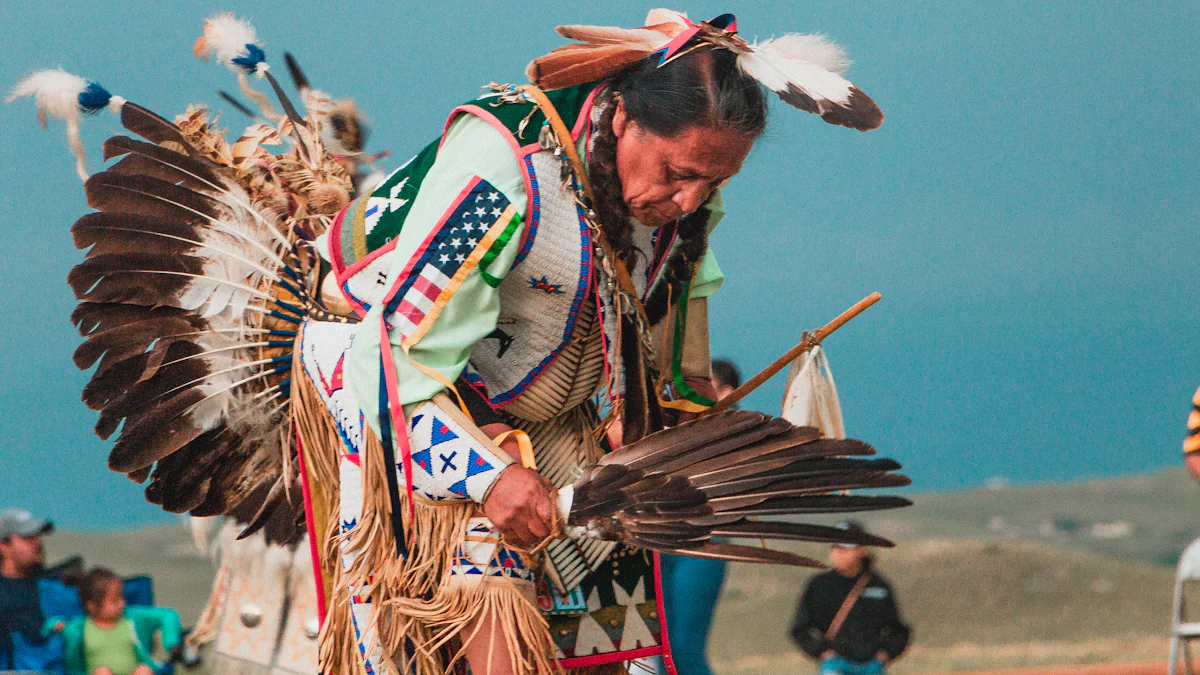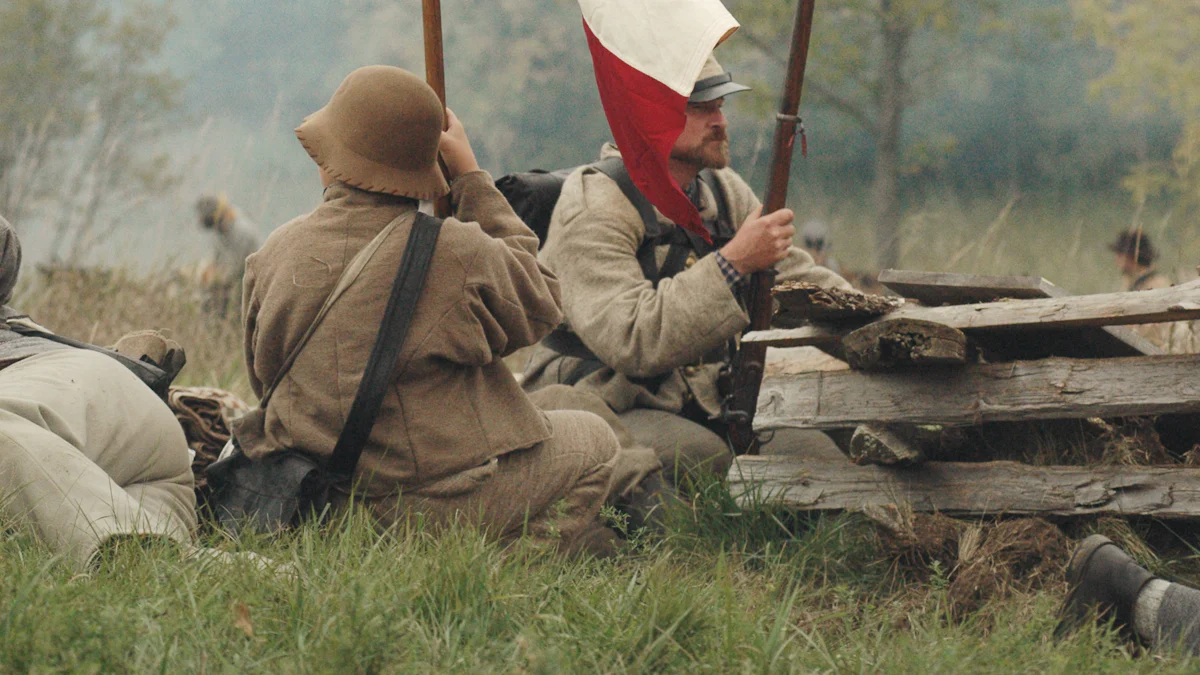American History: A Visual Encyclopedia

Understanding U.S. history is essential for grasping the nation's identity and evolution. American history provides a foundation for identity formation and understanding of the past. Nations encourage teaching history to foster a sense of identity. In 2022, only 13% of students achieved proficiency in U.S. history. This statistic highlights the need for engaging educational resources. A chronological approach enriched with visual elements enhances learning. Join a fascinating journey through time, exploring pivotal moments that shaped American history. The journey offers insights into the nation's remarkable evolution.
Early Native American Cultures

Pre-Columbian Societies
Major Tribes and Cultures
Pre-Columbian societies in North America thrived with diverse cultures and tribes. The Great Basin culture area included people who foraged for roots, seeds, and nuts. These communities lived in compact structures called wikiups, made from willow poles. Sedentary farmers such as the Hopi, Zuni, Yaqui, and Yuma cultivated crops in pueblos. The Northeast culture area featured Iroquoian and Algonquian speakers. Plains culture area inhabitants adapted to a more nomadic lifestyle after European contact.
Daily Life and Traditions
Daily life in these societies revolved around community and nature. People used fire and domesticated animals for various purposes. Stone implements, spear-throwers, and bows and arrows served as essential tools. Pottery played a crucial role in daily activities. Domesticated plants and animals provided sustenance. Traditions included storytelling, ceremonies, and rituals that connected them to their environment and ancestors.
European Contact
Initial Encounters
European explorers arrived on North American shores, marking a new chapter in history. Initial encounters between Europeans and Native Americans varied greatly. Some interactions involved trade and cultural exchange. Others led to conflict and misunderstanding. The arrival of Europeans introduced new goods and technologies to Native American societies.
Impact on Native Populations
The impact of European contact on Native populations proved profound. Diseases brought by Europeans decimated many communities. The introduction of horses transformed the lifestyle of Plains tribes, making them more mobile. European colonization led to the displacement of numerous Native American groups. Cultural changes occurred as Native Americans adapted to new circumstances. Despite challenges, Native American cultures demonstrated resilience and adaptability.
Colonial America
The Thirteen Colonies
Founding and Development
The founding of the Thirteen Colonies marked a significant chapter in American history. English settlers established the first permanent colony at Jamestown in 1607. The Pilgrims founded Plymouth Colony in 1620, seeking religious freedom. Colonists created settlements along the Atlantic coast, each with distinct characteristics. The Southern Colonies focused on agriculture, growing crops like tobacco and rice. The Middle Colonies developed diverse economies with farming and trade. The New England Colonies emphasized shipbuilding and fishing industries. Each colony operated under a charter granted by the British Crown.
Colonial Life
Colonial life varied greatly across the regions. In the Southern Colonies, plantations dominated the landscape. Wealthy landowners relied on enslaved labor for farming. The Middle Colonies featured bustling towns and cities. Merchants and artisans thrived in these urban centers. New England communities centered around churches and schools. Puritan values influenced daily life and governance. Colonists faced challenges such as harsh winters and conflicts with Native Americans. Despite hardships, colonists built thriving communities with unique cultural identities.
Road to Independence
Key Events Leading to Revolution
Tensions between colonists and British authorities escalated over time. The British government imposed taxes like the Stamp Act and Tea Act. Colonists protested against taxation without representation. The Boston Massacre in 1770 fueled anti-British sentiment. The Boston Tea Party in 1773 demonstrated colonial resistance. The First Continental Congress convened in 1774 to address grievances. Armed conflict erupted at Lexington and Concord in 1775. These events set the stage for the American Revolution.
Declaration of Independence
The Declaration of Independence marked a pivotal moment in history. The Continental Congress approved the document on July 4, 1776. Thomas Jefferson drafted the Declaration, outlining grievances against Britain. The document proclaimed the colonies' right to self-governance. The Declaration asserted that all men are created equal. The approval of the Declaration signified a formal break from Great Britain. The colonies united in their fight for independence. France's entry into the war transformed the conflict into an international struggle. The support from France proved crucial in securing American victory.
The Formation of a New Nation
The American Revolution
Major Battles and Leaders
The American Revolution featured several pivotal battles. The Battle of Saratoga marked a turning point. American forces defeated British troops advancing from Canada. This victory prevented British control of New York’s Hudson River Valley. The Battle of Cowpens played a crucial role in the southern campaign. American forces liberated South Carolina from British control. The Battle of Yorktown saw George Washington lead a combined French and American army. The defeat and capture of General Cornwallis forced Great Britain to negotiate. The Battle of Bunker Hill was the first major battle. Colonial forces inflicted heavy casualties on the British regiment of General William Howe. These battles demonstrated the determination and resilience of American leaders and troops.
Outcome and Significance
The American Revolution concluded with significant outcomes. The Treaty of Paris in 1783 officially ended the war. Great Britain recognized American independence. The new nation gained territory extending to the Mississippi River. The revolution inspired other countries seeking independence. The American Revolution highlighted the importance of self-governance. The success of the revolution established the United States as a sovereign nation. The struggle for independence laid the foundation for future democratic principles.
The Constitution and Bill of Rights
Drafting and Ratification
The drafting of the Constitution began in 1787. Delegates gathered at the Constitutional Convention in Philadelphia. The goal was to create a stronger national government. The Constitution established a system of checks and balances. The document outlined the structure of the federal government. The ratification process required approval from nine states. The Federalist Papers supported the Constitution's ratification. James Madison, Alexander Hamilton, and John Jay authored these influential essays. The Constitution became the supreme law of the land in 1789.
Key Amendments
The Bill of Rights introduced essential amendments. The first ten amendments aimed to protect individual liberties. The First Amendment guaranteed freedoms of speech, religion, and assembly. The Second Amendment addressed the right to bear arms. The Fourth Amendment protected against unreasonable searches and seizures. The Fifth Amendment ensured due process of law. The Tenth Amendment reserved powers to the states and the people. These amendments underscored the importance of personal freedoms. The Bill of Rights remains a cornerstone of American democracy.
The Civil War and Reconstruction

Causes of the Civil War
Slavery and States' Rights
Slavery played a central role in causing the Civil War. Southern states relied heavily on enslaved labor for their agricultural economy. Northern states opposed the expansion of slavery into new territories. The debate over states' rights intensified tensions. Southern leaders argued that states had the right to decide on slavery. Northern leaders believed in a strong federal government to regulate slavery.
Economic and Political Factors
Economic differences contributed to the conflict. The North developed an industrial economy with factories and railroads. The South remained agrarian, relying on cotton and slave labor. Political disputes arose over tariffs and trade policies. Southern states felt marginalized by Northern economic interests. The election of Abraham Lincoln in 1860 heightened fears. Southern leaders believed Lincoln threatened their way of life.
Major Battles and Turning Points
Gettysburg and Antietam
The Battle of Gettysburg marked a turning point in the Civil War. Union forces repelled General Robert E. Lee's invasion of the North. This victory boosted Northern morale and ended Lee's offensive strategy. The Battle of Antietam became the bloodiest single-day battle in American history. Union forces halted the Confederate advance into Maryland. President Lincoln issued the Emancipation Proclamation after this battle.
Emancipation Proclamation
The Emancipation Proclamation transformed the war's purpose. President Lincoln issued the proclamation on January 1, 1863. The document declared freedom for enslaved people in Confederate states. The proclamation shifted the focus from preserving the Union to ending slavery. This action encouraged African Americans to join the Union army. The Emancipation Proclamation strengthened the moral cause of the Union.
Reconstruction Era
Challenges and Achievements
Reconstruction faced numerous challenges after the Civil War. Southern states needed to rebuild their economies and infrastructure. The federal government implemented policies to integrate formerly enslaved people. The Freedmen's Bureau provided assistance to newly freed individuals. Reconstruction Amendments aimed to secure civil rights for African Americans. The 13th Amendment abolished slavery in 1865. The 14th Amendment granted citizenship and equal protection under the law. The 15th Amendment ensured voting rights regardless of race.
Legacy and Impact
Reconstruction left a lasting impact on American society. The era laid the groundwork for future civil rights movements. African Americans made significant political and social gains during this time. Resistance and violence from groups like the Ku Klux Klan hindered progress. The end of Reconstruction in 1877 led to the rise of Jim Crow laws. These laws enforced racial segregation and disenfranchisement in the South. Despite setbacks, Reconstruction marked a crucial step toward equality.
The 20th Century and Beyond
World Wars and the Great Depression
America's Role in WWI and WWII
The United States played a crucial role in both World Wars. American forces joined the Allies in 1917 during World War I. This involvement helped turn the tide against the Central Powers. In 1941, the attack on Pearl Harbor led to U.S. entry into World War II. American troops fought in Europe and the Pacific, contributing to the defeat of Axis powers.
Economic Challenges and Recovery
The Great Depression began in 1929 and affected millions. Unemployment rates soared as businesses failed. Government programs like the New Deal aimed to provide relief. These initiatives focused on job creation and economic recovery. World War II further stimulated the economy through industrial production.
Civil Rights Movement
Key Figures and Events
The Civil Rights Movement sought equality for African Americans. Rosa Parks refused to give up her seat, sparking the Montgomery Bus Boycott. Martin Luther King Jr. emerged as a leader, advocating nonviolent protest. The Greensboro sit-in involved four students challenging segregation at a lunch counter. The Selma to Montgomery march protested voting rights violations.
Legislation and Social Change
Significant legislation transformed American society. The Civil Rights Act of 1964 ended segregation in public places. The Voting Rights Act of 1965 ensured voting rights for all citizens. These laws marked major victories for civil rights activists. Social change continued as more Americans embraced equality.
Contemporary America
Technological Advancements
Technological advancements have reshaped modern life. The internet revolutionized communication and information access. Innovations in medicine improved healthcare and extended life expectancy. Space exploration expanded human understanding of the universe. Technology continues to influence daily activities and global connections.
Current Social and Political Issues
Contemporary America faces various social and political issues. Debates over healthcare, immigration, and climate change persist. Movements for racial justice and gender equality gain momentum. Political polarization affects governance and public discourse. These challenges shape the nation's future and require thoughtful solutions.
American history offers a profound journey through time. This exploration reveals the nation's identity and evolution. Understanding history provides tools to analyze past events. These insights help shape future decisions and ethical behavior. Learning from history fosters critical thinking and cultural awareness. This knowledge encourages responsible citizenship and informed decision-making. Curiosity about the past inspires further exploration. American history remains a rich tapestry of lessons and stories. Engaging with this history enriches our understanding of the present.
See Also
Visual Guide to the History of Britain and Ireland
Illustrated History of Ancient Egypt
Visual History of Armored Vehicles: Tanks

